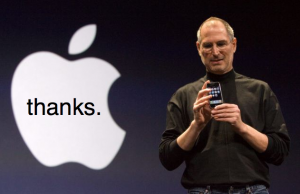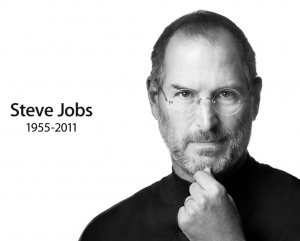I first met Robert back in my Slingbox days, and now we get together a few times a year to chat tech in general, kid stuff, but especially gadgetry. He sat down with myself and Maksim (the CEO of Dijit) this past summer, and a couple of weeks ago I went to see him and his new digs at Rackspace HQ. Here’s the video:
A quick summary of what we discussed:
- CES 2012
- Gadgets
- Future of TV
- Social TV
- CES 2011
- Kids
- Tech
- CES 2010
- Gadgets
- TV
- Dijit’s iPad app
- CES (all others)
And for a fun flashback, here’s the video from our chat right before CES 2009:
good times, Robert, thanks!
 I surprised myself with the emotional reaction to hearing about Steve Jobs’ passing yesterday. I guess I knew it was coming, but having never met the man, didn’t expect to have “a moment” about it. After reading words from
I surprised myself with the emotional reaction to hearing about Steve Jobs’ passing yesterday. I guess I knew it was coming, but having never met the man, didn’t expect to have “a moment” about it. After reading words from 


















 Definition: For sake of discussion, I’ll define the First Age of Gadgets as starting with calculators and LCD watches (and, of course, calculator watches). Sticklers will quickly point out something I’m missing, but in my opinion that’s when the concept of “gadgets” really got kicking. These products (1) required batteries and (2) did one thing, typically pretty well. These early gadgets were typically fairly functional in nature, not very gimmicky or showy. They were also workhorses as compared to modern products – you can drop most “old school” products and not fear for significant damage (probably directly related to LED or single-line LCD outputs).
Definition: For sake of discussion, I’ll define the First Age of Gadgets as starting with calculators and LCD watches (and, of course, calculator watches). Sticklers will quickly point out something I’m missing, but in my opinion that’s when the concept of “gadgets” really got kicking. These products (1) required batteries and (2) did one thing, typically pretty well. These early gadgets were typically fairly functional in nature, not very gimmicky or showy. They were also workhorses as compared to modern products – you can drop most “old school” products and not fear for significant damage (probably directly related to LED or single-line LCD outputs). Definition: In a nutshell: USB connectivity and/or card reader integration. Slightly more detailed: the Second Age of gadgets is about products that were able to connect and/or share data with a computer (but did not include WiFi) and/or cell phones. Gadgets started becoming a little more pervasive, a little more mainstream, a lot more pop culture. In addition to the gadgets themselves, the category of gadget accessories really began to boom (chargers, carrying case, rechargeable batteries, etc). This was also the dawn of the gadget blogs. I asked Peter Rojas, founder of Gizmodo, if he could recall why he launched the site: “It was an experiment, something Nick and I started almost by accident. I don’t think either of us thought blogging would become as big as it did. People are a LOT more interested in gadgets now than when I started Gizmodo in 2002 – it’s become part of pop culture.”
Definition: In a nutshell: USB connectivity and/or card reader integration. Slightly more detailed: the Second Age of gadgets is about products that were able to connect and/or share data with a computer (but did not include WiFi) and/or cell phones. Gadgets started becoming a little more pervasive, a little more mainstream, a lot more pop culture. In addition to the gadgets themselves, the category of gadget accessories really began to boom (chargers, carrying case, rechargeable batteries, etc). This was also the dawn of the gadget blogs. I asked Peter Rojas, founder of Gizmodo, if he could recall why he launched the site: “It was an experiment, something Nick and I started almost by accident. I don’t think either of us thought blogging would become as big as it did. People are a LOT more interested in gadgets now than when I started Gizmodo in 2002 – it’s become part of pop culture.” Definition: Internet access and connectivity. Devices had either built-in Internet access, or some hybrid method of interacting with the Internet to share content, data, or services. In many cases Third Age devices are simple evolutions to their predecessors, but some innovated distinctly enough so that there’s no blurry lines. Just as the
Definition: Internet access and connectivity. Devices had either built-in Internet access, or some hybrid method of interacting with the Internet to share content, data, or services. In many cases Third Age devices are simple evolutions to their predecessors, but some innovated distinctly enough so that there’s no blurry lines. Just as the  Displays: I assume we’ll be seeing flexible display surfaces (folding, roll-up, etc) that change the way we physically interact with a device. The concept of a hard, flat screen (even a touchable one) seems very outdated to me. I think the real revolutionary tablet will be the first one with some form of flexible display (and my money’s on Apple for making this happen). I also foresee better use of microprojectors to remove the need for an on-board display at all.
Displays: I assume we’ll be seeing flexible display surfaces (folding, roll-up, etc) that change the way we physically interact with a device. The concept of a hard, flat screen (even a touchable one) seems very outdated to me. I think the real revolutionary tablet will be the first one with some form of flexible display (and my money’s on Apple for making this happen). I also foresee better use of microprojectors to remove the need for an on-board display at all. That’s “ennui”, not “envy”, and I’m writing about the fairly dull times we are living in. From an awesome new gadget perspective, that is.
That’s “ennui”, not “envy”, and I’m writing about the fairly dull times we are living in. From an awesome new gadget perspective, that is.